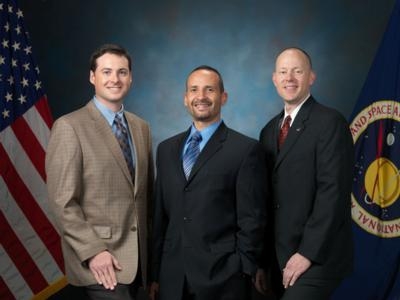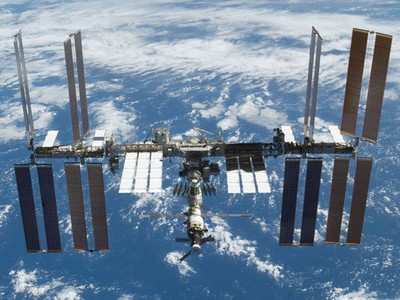Will Head Up Teams Of Flight Controllers For ISS
Operations
NASA has selected three new flight directors to manage
International Space Station operations. Judd Frieling, Tomas
Gonzalez-Torres and Greg Whitney will join a select group of human
spaceflight leaders in the Christopher C. Kraft Jr. Mission Control
Center at NASA's Johnson Space Center in Houston. NASA's flight
directors lead a team of flight controllers, support personnel and
engineering experts from around the world. They also are involved
in cargo and crew vehicle integration with the station and
developing plans for future exploration missions.
(L-R) Whitney, Gonzalez-Torres,
Frieling

"As we move into a new era of spaceflight, these flight
directors will help us transition the knowledge and experience from
the existing human spaceflight programs into the next period of
exploration and space station operations," said John McCullough,
chief of the Flight Director Office at Johnson. "This includes
development of new technologies and techniques for spaceflight and
development and execution of our future missions in the years to
come."
After the new flight directors have completed their training and
certification, NASA will have 25 active flight directors supporting
the space station, exploration, commercial spaceflights and new
technology demonstration initiatives. Prior to the selection of
Frieling, Gonzalez-Torres and Whitney, only 80 people had served as
NASA flight directors in the almost 50 years of human
spaceflight.
Judd Frieling was born in Austin, Texas, but considers
Pflugerville, Texas, his hometown. He earned a Bachelor of Science
degree in aerospace engineering from the University of Texas in
1996. He began a diverse flight control career in 1997 as an
Onboard Data Interfaces and Network (ODIN) officer, serving as lead
for the STS-97 station assembly mission, and worked to resolve
multiple computer failures during the STS-100 mission. He was
instrumental in developing new operations processes and procedures,
allowing the Mission Control Center to operate with significantly
smaller staffs during quiet periods aboard the station. In 2004,
Frieling transitioned to space shuttle flight control as a Data
Processing Systems (DPS) officer, where he supported 20 shuttle
flights. He served as lead DPS officer for STS-118 and STS-130.

Tomas Gonzalez-Torres was born in Rio Piedras, Puerto Rico. He
earned a Bachelor of Science in aerospace engineering from Iowa
State University in 1998. A veteran spacewalk flight controller,
Gonzalez-Torres has been the group lead for the Extravehicular
Activities (EVA) Systems Group for the past three years, and
recently has been acting chief of the EVA Operations Branch. He
joined NASA in 1994 and worked as a spacewalk task and systems
instructor. Gonzalez-Torres became an EVA officer in 2005, working
17 shuttle flights, including lead for the STS-121 assembly mission
that featured tests of shuttle heat shield inspection and repair
techniques. He served as the lead spacewalk officer for the final
Hubble Space Telescope servicing mission, STS-125, and four space
station expedition spacewalks.
Greg Whitney was born in Albany, N.Y., but considers Rye, N.H.,
his hometown. He earned a Bachelor of Science in aerospace
engineering from the University of Texas in 2002. He joined NASA in
2002 and supported space station activities as an Operations
Planner. Whitney also supported space shuttle missions as a Flight
Activities Officer (FAO), developing plans to optimize crew
operations. This resume includes 14 space station expeditions and
12 space shuttle missions, and he served as the lead FAO for the
last shuttle flight, STS-135, earlier this year. He also spent time
as an acting group lead for spaceflight planning activities.
 Aero-News: Quote of the Day (10.16.25)
Aero-News: Quote of the Day (10.16.25) Airborne 10.15.25: Phantom 3500 Confounds, Citation CJ3 Gen2 TC, True Blue Power
Airborne 10.15.25: Phantom 3500 Confounds, Citation CJ3 Gen2 TC, True Blue Power ANN's Daily Aero-Term (10.16.25): Enhanced Flight Vision System (EFVS)
ANN's Daily Aero-Term (10.16.25): Enhanced Flight Vision System (EFVS) True Blue Power and Mid-Continent Instruments and Avionics Power NBAA25 Coverage
True Blue Power and Mid-Continent Instruments and Avionics Power NBAA25 Coverage NTSB Final Report: Bellanca 17-30A
NTSB Final Report: Bellanca 17-30A




